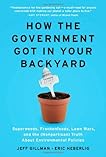 How the Government Got in Your Backyard
How the Government Got in Your Backyard by Jeff Gillman
My rating: 3 of 5 stars
How the Government got in Your Backyard / 978-1-60469-001-9
I read a lot of books on health, food, and government policy, so I was really excited to get this book, but I ended up being very disappointed.
Firstly, the tone is very unpleasant. The book waffles between a very snide 'superior' tone - there's a whole section on how "If you like your opinions and don't think that appreciating the other side of an argument is important, then we encourage you to put this book down right now, because it wasn't written for you," and it just comes off as very self-congratulatory - and a very dry, unfocused 'scholarly' tone, with the book skimping all over the place on specific issues, and comes across as very disorganized.
Secondly, the 'facts' contained herein are incredibly superficial, with almost zero documentation. Weasel words are employed frequently, names and studies are never cited, and there are zero footnotes to back up the authors claims. One example early on that bugged me immensely was this: "A dairy in California was brought to the attention of the USDA in 2005 for violating organic standards... A supplier of organic milk to major retailers line Wal-Mart and Trader Joe's received a letter from the USDA in 2007 telling it to clean up its act or risk losing certification..." Much of the book reads this way, and it's very frustrating! "A dairy" - which one? "A supplier" - where? When "studies" are said to show something, we never hear where the study was conducted, or who conducted it. This is very important information, and leaving it out means that we just have to take the authors' words for everything. I understand not wanting to break the narrative, but that's what footnotes and citations are for - the two college professors who wrote this book should surely understand that!
Thirdly, a lot of this "nonpartisan" (as the subtitle claims) book smells like the Golden Mean fallacy. There's a lot of talk about Al Gore (here provided as the example of liberal extremism) and Sarah Palin (here provided as the example of conservative extremism), with the implication that the truth obviously lies somewhere nicely in the middle. It's hard to shake the feeling that a lot of the weasel words are employed to support this Golden Mean fallacy - for instance, when the authors seem to shake off the concern that the use of rBST in milk cows may be linked to cancer with the statement that "The FDA, however, cites research that shows that rBST...". I don't like the phrasing here. What research? Who conducted it? Is it reasonable research? Should we trust it? Notice that the authors aren't really agreeing or disagreeing with the research - they're merely repeating the 'fact' that the FDA cited some research at least once. Are we to really take from that 'fact' that rBST concerns are over-blown and Republicans and Democrats need to meet somewhere in the middle on rBST? And what IS the 'middle' for rBST - half rBST milk and half organic milk?
Since I received an Advance Review Copy of this book from Vine, I'm hoping that the complete lack of citations and footnotes is some quirk of the ARC, and that they will be included in the full version. For that, I'll give this 3 stars, but if the published copy is the same as the ARC I received, I wouldn't give more than 2 - the shoddy scholarship and rushed writing makes me very nervous, and I'd rather turn to one of the many, many alternatives available in the field of environmentalism.
NOTE: This review is based on a free Advance Review Copy of this book provided through Amazon Vine.
~ Ana Mardoll
View all my reviews



0 comments:
Post a Comment